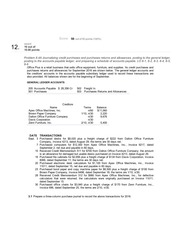
The faster companies can collect payment from customers, the sooner they can use the resulting cash to cover operating costs, build resilience, generate returns from investment, or drive revenue growth. One of the best ways to streamline receivable management is to automate it. It will help you manage global nuances, get accurate insights into customer behavior, and benefit from differentiated functionalities for timely and speedy collections.
Step 5A: Writing Off Uncollectible Debts
Companies get paid faster when customers can have transparent access to their account, view invoice statuses, and easily make online payments. Organizations that still rely on manual invoicing techniques—and subsequently maintain poorer AR management processes—limit their cash flow and growth. One of the primary goals of accounts receivable management is to ensure the timely collection of outstanding invoices. This ensures strong cash flow and can what are temporary accounts fanda glossary strengthen your customer relationships. The timing for this can vary by industry and should be in line with your company’s financial policies.
It’s a good practice to initiate dispute resolution promptly if any issues arise. This helps maintain positive customer relationships and increases the chances of invoice payment. There are a variety of commonly accepted payments for small businesses, including e-transfer, ACH, credit, debit, check, and online payments. Your business may choose to accept some or all of these payment methods as outlined inventory purchases in your sales order and invoice. To begin the ordering and Accounts Receivable process, a customer will place an order that needs to be approved by the business. Once the company receives and approves this order, it generates a sales order which includes details about quantity, price, payment date, and any other relevant terms of sale.

Better Customer Experience
One way to overcome AR management challenges is by regularly monitoring and analyzing key metrics. Regularly follow up on past due invoices and overdue payments, which involves tracking payment due dates and contacting clients to remind them of outstanding invoices. Try to set automatic reminders to streamline this process and minimize the chances of human error.
The customer credit assessment step helps businesses choose customers who are more likely to pay reliably and on time. The Accounts Receivable process is the set of steps a business follows to invoice a client and collect payment. It’s essential for managing a smooth transition from sales to revenue and ensuring that a business maintains a healthy cash flow.
- To illustrate, Company A cleans Company B’s carpets and sends a bill for the services.
- Credit policies include such important guidelines as the criteria used for evaluating customers’ credit worthiness, limits on how much credit may be extended, and the terms for repayment of credit.
- The receivables turnover ratio is the inverse of the receivables-to-sales ratio.
- To create this report, you’ll group your accounts receivable balances by the age of each invoice.
Step 5B: Payment Processing
Accounts receivable (AR) is an accounting term for money owed to a business for goods or services that it has delivered but not been paid for yet. Accounts receivable is listed on the company’s balance sheet as a current asset. An aging report categorizes accounts receivable by the length of time an invoice has been outstanding. It helps businesses identify overdue accounts and assess the effectiveness of their collections process.
Note that although lockbox services eliminate the need for you to receive checks at your office, they don’t take away the effort involved in processing them. Going through lockbox files to apply payments to invoices still takes work. To do this, you need accounts receivables management, popularly known as a credit management system in place.
Most AR teams must navigate a patchwork of legacy systems, reports, spreadsheets, and tools to retrieve data and complete work. Siloed, hard-to-find data prevents learning from real-time and historical data. Marshall Hargrave is a financial writer with over 15 years of expertise spanning the finance and investing fields. He has experience as an editor for Investopedia and has worked with the likes of the Consumer Bankers Association and National Venture Capital Association.
Not having well-defined policies and practices in place, especially as they concern credit and collections, can hinder the business’s ability to collect payment and sour relationships with customers. A lower ADD means customers remit faster and is a sign of effective AR management practices. ADD is most valuable when evaluated as a trend over time and in comparison with other metrics, like DSO. Fifty-five percent of AR professionals say dispute management is their most difficult task. Making this AR management process easier can improve both employee happiness and resource management internally, and customer experience on the external side. Late payments aren’t always the buyer’s fault – the range of payment options the supplier offers can impact on-time payments too.
At some point along the way, interest on the debt might also begin to accrue. The April 6 transaction removes the difference between gross sales and net sales the accounts receivable from your balance sheet and records the cash payment. You receive the cash in April but correctly recorded the revenue in March.
